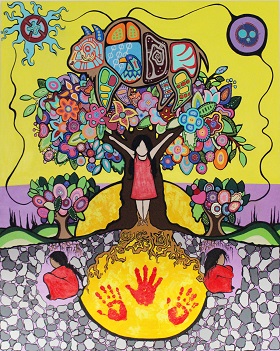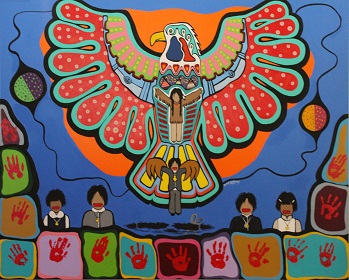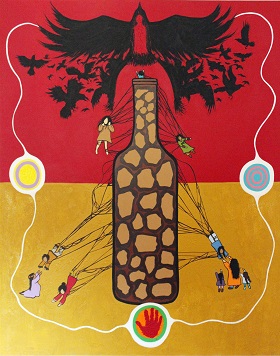 Air Ronge artist Donna Langhorne is not one to shy away from difficult topics. Her recent body of work, a series of seven large paintings, addresses contemporary issues facing Indigenous peoples. Topics include addiction, missing and murdered Indigenous women and residential school experiences.
Air Ronge artist Donna Langhorne is not one to shy away from difficult topics. Her recent body of work, a series of seven large paintings, addresses contemporary issues facing Indigenous peoples. Topics include addiction, missing and murdered Indigenous women and residential school experiences.
"I wanted to deal with subjects that were important to be addressed in a new light. We can only move toward reconciliation by talking about them instead of sweeping them under the rug. And sometimes you have to back up and take a look at things in a different way. Art is a powerful means to do that,” she says. “One of the core observations of the Truth and Reconciliation report is that ‘there is no reconciliation without truth telling.’ This is also at the centre of my project and its objectives”.
Langhorne is a self-taught artist who started out sketching and cartooning. She taught herself to paint seven years ago, initially exploring abstract and pop art styles. She became inspired by the work of Norval Morrisseau, a Canadian Indigenous artist who created the Woodlands style of art, characterized by thick black outlines and bright colours.
In 2014, Langhorne received an Indigenous Pathways Initiative grant from the Saskatchewan Arts Board to create an extensive series of paintings highlighting both positive and negative experiences and conditions that characterize life in northern communities. Reflecting on that work, she says “the series presented a balanced perspective of life in Northern Saskatchewan today – not shrinking back from the horrors of poor choice, but freely embracing the uniquely human desire for a hopeful future. This dual thrust allowed me to explore both the challenges facing northern communities and to celebrate the richness of northern tradition and culture. I found that the project took me in new directions artistically, thematically and stylistically. As a result, there is a great deal of myself, of my own identity, that informs those paintings.”

The project also provided her the opportunity to explore the Woodlands style for the first time. “My own Aboriginal ancestry as Plains Ojibway connects me directly to Morrisseau’s cultural and tribal history. I felt completely comfortable and at home in this style. So, with approval from elders, I created my first painting, The Everlasting North, using this approach, and it came to serve as the launching point for the next stage of my practice.”
“I received a lot of positive feedback on this painting and was encouraged to explore the style further,” she says. Langhorne felt the bold style was a good fit for her new project and its subject matter.
Although Langhorne received another Arts Board grant in 2016, to tackle the Reconciliation series of paintings, the jury was only able to give her two-thirds of the requested amount, as there were not sufficient funds available to support all of the recommended applications. She was determined to raise the necessary amount to complete the project, however, undertaking an online crowdfunding campaign and holding several garage sales. “I really believed in it, and so I was going to do everything I could to see it through.” The funding shortfall meant the project took her longer than expected – one year instead of three months. “This is the biggest project in my career as an artist to date. There aren’t many paintings on these difficult subjects, so I felt it was really important for me to document them on canvas,” she says.

Each of the paintings is influenced by one of the Seven Sacred Teachings – courage, respect, truth, humility, honesty, love and wisdom – and is associated with an animal symbol. The painting dealing with residential schools uses the sacred teaching of love and the symbol of the eagle. “I’ve received many thank yous for taking on this theme. Every painting has moved people in different ways, depending on their personal experience. For example, the residential school painting has touched a lot of hearts around here. That painting means a lot to my birth mother, who is a residential school survivor,” she says.
Langhorne entered the residential school painting in a juried art exhibit hosted by the La Ronge Arts Council. It was chosen by the Organization of Saskatchewan Arts Council adjudicators as “best of show.” Now the La Ronge Arts Council is negotiating with Langhorne to exhibit all seven of the recently completed works.
“This project is important because it allowed me to explore a painting style that is relatively new to me and grow artistically. It is also of tremendous personal value, as it allowed me to research and come to terms with my own heritage and develop a better understanding of the root causes of the pressures that Indigenous people contend with,” she says.
To see more of Donna Langhorne’s artwork, visit her Facebook page.
Images:
Top: Respect [Buffalo] - For Missing and Murdered Indigenous Women
Middle: Love [Eagle] - For Residential School Victims
Bottom: Honesty [Raven] - For Victims of Addiction
